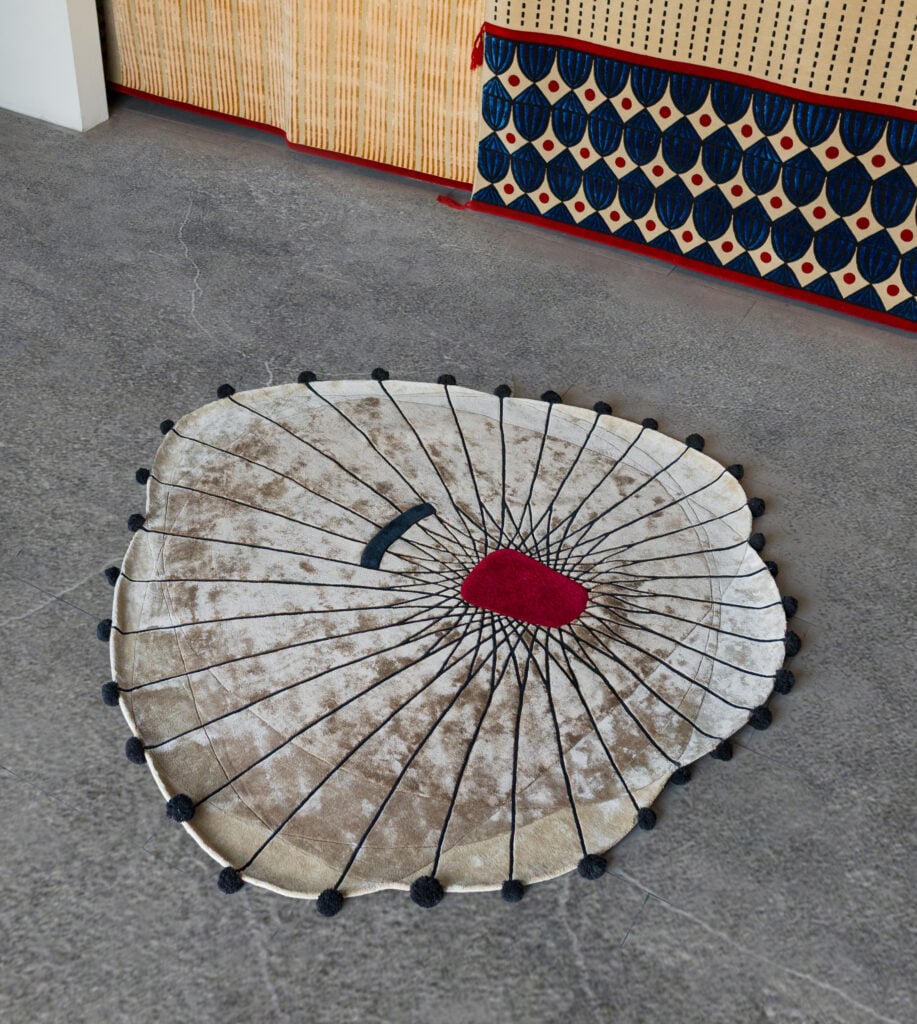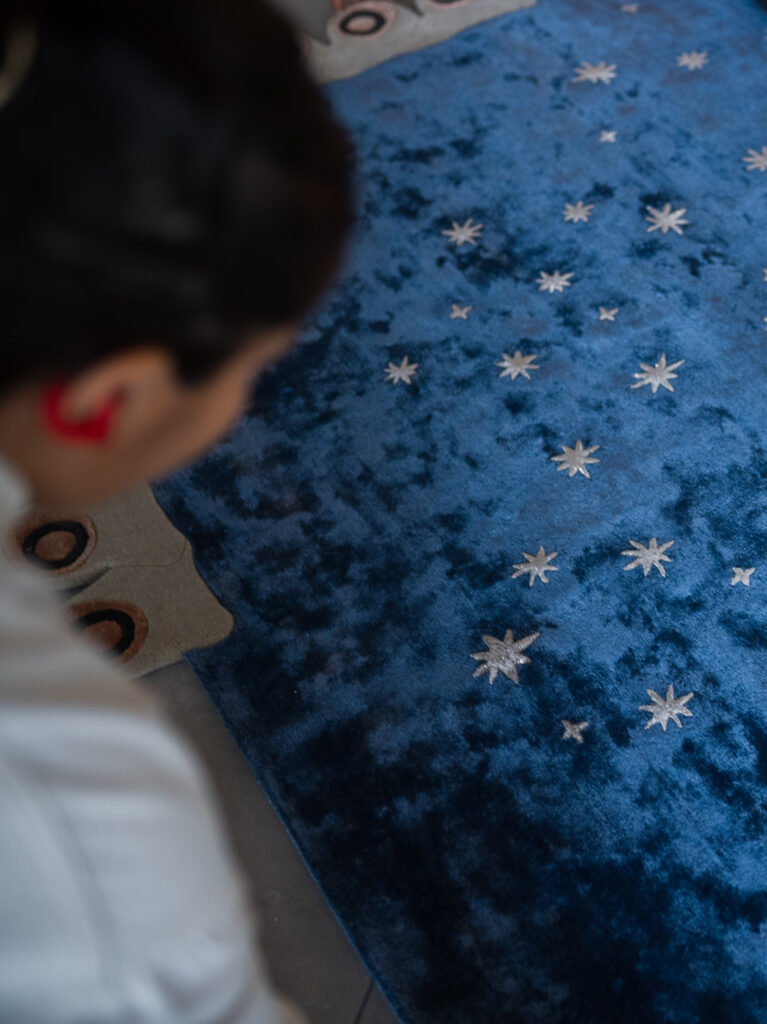News
“Postcards” is a 10-piece capsule collection born from a collaboration between Indian heritage atelier Hands Carpets and Dubai-based design duo Doodle and the Gang. Drawing inspiration from five cities, Cairo, Beirut, Dubai, Riyadh, and Varanasi, each rug is both hand-knotted and tufted in the very city that inspired it.
A year in the making, the collection captures the symbols and monuments that hold deep meaning for sisters Mentalla and Asmaa Said, the creative force behind Doodle and the Gang. Having grown up between Cairo and Beirut, settled in Dubai, found kinship in Riyadh, and drawn inspiration from collaborators in Varanasi, the duo infused “Postcards” with personal history and sentiment. The collection feels like a brainchild and a lovechild, born of nostalgia, memory, and passion.
“This collection was about nostalgia, and the stories from other places also had a high nostalgic value for a common taste,” says Hands Director, Pranay Patodia. “Our relationship with Asmaa and Menna goes a long way, and we have worked on this collection with utmost passion. We are regular participants at Downtown Design, and we feel it is our job to bring something creative to the show for people to enjoy. It has to be something out of the ordinary.”
And they did just that. Refraining from falling into the nostalgia trap or relying on clichéd imagery, the designers turned instead to the texture of real experience. Each rug stems from moments they genuinely lived. And so have people who came before them, and so will those who come after.
“We didn’t want to go down the Burj Khalifa route,” Asmaa states. “We wanted to be more nostalgic, more iconic. We didn’t want to dedicate something to Egypt and just draw pyramids.”

For example, “Aroosa,” the namesake black tea that has been a staple in Egyptian kitchens for generations, arranges the smiling doll figure on its iconic red packaging neatly in two rows along the edge. Extending through sharp yellow lines, the doll’s image unfolds into a bold geometric sequence that celebrates taste and tradition.
“[Aroosa] is possibly not the best tasting because it’s really strong with this bitter sweetness,” Asmaa says. “But it just tastes like home.”
“A-Bae-A” takes the abstract silhouette of an older Emirati woman, black sheila on top shimmering with gold to evoke her burqa, falling over a floral red and golden polka-dot dress. Obscuring and softening the pattern, layers of cloth are woven into layers of a Dubai story hidden in plain sight—resilience and quiet power. Especially in a place like this, there’s more than what meets the eye.

“You don’t have to be from the region to know that, you just have to have met some of the people here,” said Menna. “It’s not obvious, and it shows how layered Dubai can be.”
The sharp china blue spiderwebs of Al Khazzan Water Tower in Satwa, imagined in “Khazzanz,” where the shapes, rounded and repeated in silk, become motion themselves. Menna recalls spending afternoons playing in the eponymous park, which is still there, as well as the monument she grew up with. At one point, before the glitz and the expats, Al Khazzan was the only water tower in Dubai.
“Marigold,” named after the ceremonial flowers that hang everywhere in India, in garlands, on thresholds, as offerings, lingering in noses; made from vibrant leftover yarn salvaged from the studio, spilling out in fiery arcs like a firework falling. The one-of-a-kind vertical rug, meant to perch on a wall, ensures the hand-weaving traditions in the rug industry, passed down and refined over generations, get seen, valued and remembered on a world stage.

From Riyadh’s desert majlis reimagined in “Starry Night,” Cairo’s whirling Tannoura dancers in “Twirl”, and sticky-sweet Beirut kid-summers spent drinking pyramid-shaped “Bonjus” with a zaatar man’ousheh, the collection is a cultural love letter from the sisters.
“A rug is an emotion. It’s a work of art that is handmade. This is the fabric that comes in contact with our feet, offering comfort after a long day. It binds the space. It also gives a large canvas to convey the message giving enough space to play with.” – Pranay Patodia, Hands Director
As for Varanasi, the Indian city, the inspiration was milk and butter. “As someone born and brought up in Varanasi, butter is a very integral part of daily lives,” says Pranay. “From late-night bread, butter and tea outings to extra butter on parathas, this was something not only unique to Varanasi but India on the whole. We have seen these colours on our butter packaging since we were children. Many alternatives have come, but nothing was able to replace this. We are a milk and butter-loving nation.”
The title, “Postcards,” was in part inspired by their grandfather, a photographer who always brought back black-and-white film prints from his travels with names, dates and even journal entries scrawled over the back. Asmaa says that as kids, they would always go back to these photos and be inspired. In a way, these were their first postcards.

Menna says her generation is “hopelessly nostalgic.” Having grown up in the shadow of a simpler pre-Internet, and learning to be an adult in the midst of an unyielding tech boom, one can’t help but wonder what could’ve been.
Downtown Design will be their first time showing in Dubai since 2022, having spent the last three years touring Milan, the Netherlands, London and Paris. For the Saids, the exhibit feels very full circle.
The collection will be on display at Downtown Design Dubai from November 5–9.
Words: Bryan Liu